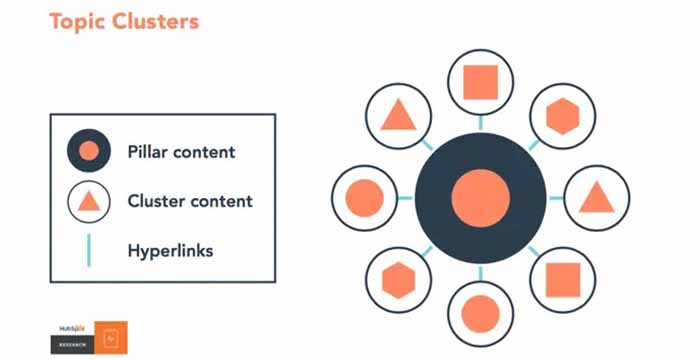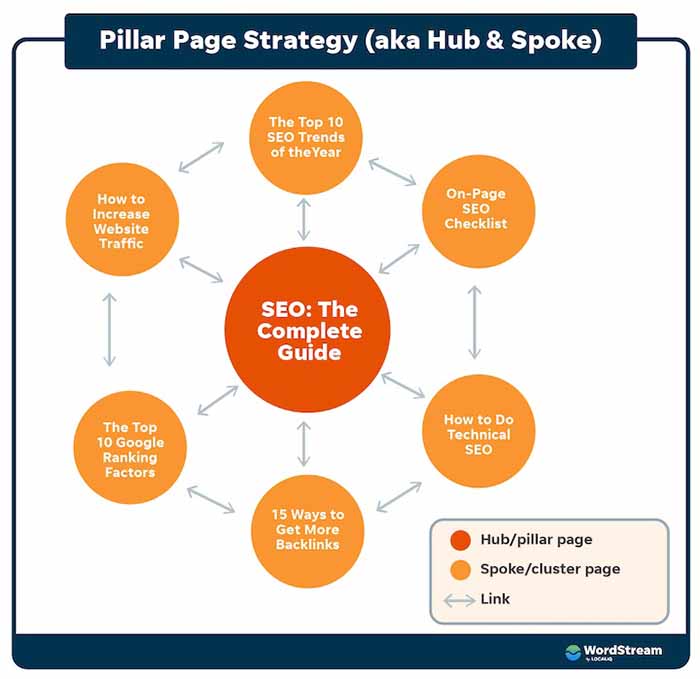
Image source
Content Pillars And Topic Clusters: A Modern Approach To SEO Content Strategy
With Google wanting you to be an authority on your topic, do you know how to structure your content into pillar pages and topic clusters?
Content pillars and topic clusters are not just buzzwords. These new SEO strategies are changing the game.
Instead of focusing on keywords, Google now cares more about you being an expert on topics. But what exactly are these content pillars and topic clusters?
When content creators organize their content around a main "pillar" page and related clusters, they improve their SEO, make users happier, and build trust.
By carefully picking topics, researching keywords, and organizing content, brands can create pillar pages as ultimate guides on their chosen subjects.
In this article, you will learn a new approach to SEO strategy and how to create pillar pages and identify topic clusters. You will also uncover the secrets of promoting and maintaining pillar pages.
Let's get started.
Table Of Contents
1. A new approach to SEO strategy
2. Why don't thin content and keyword-based SEO work anymore?
3. What is a pillar page?
4. What is a topic cluster?
5. The benefits of using pillar pages and topic clusters
6. How to create effective pillar pages to improve SEO
7. Tips for optimizing the content and structure of pillar pages
8. How to promote and maintain pillar pages
9. How to measure the success of pillar pages
10. Frequently asked questions (FAQs) about pillar pages
11. Summary
1. A New Approach To SEO Strategy
The topic cluster model is a new SEO strategy that helps content creators rank higher in search results by providing the best answers to people's questions.
First, we select the main topics for which we want to rank. Then, we create content focusing on specific keywords related to those topics. These pieces of content are connected, which helps us build a more substantial presence on search engines.
Now, to rank in search and best answer the new types of queries searchers are submitting, the solution is to use the topic cluster model:
Choose the broad topics you want to rank for, then create content based on specific keywords related to that topic that all link to each other to develop broader search engine authority.
2. Why Don't Thin Content And Keyword-Based SEO Work Anymore?
Having thin content on your website can lower your search engine rankings and make it harder for people to use it.
Thin content hurts your SEO because visitors and search engines are unhappy. It needs to provide more helpful information, which frustrates users and makes them leave your website quickly.
As a result, your website's ranking drops. Search engines prefer detailed content that answers users' questions. Websites with thin content seem less reliable and trustworthy, hurting their rank and traffic.
This kind of content also makes it difficult for search engines to understand your website's topic, which affects its ranking potential. To boost your SEO, create top-notch content that educates and engages your audience.
Before 2015, keywords were king in SEO. But nowadays, searches have become more specific and related to the situation.
In fact, according to Ahrefs, 64% of search queries contain four or more words. Google reasons that if the search terms are detailed, the results they serve should also be detailed.
In addition, with the popularity of voice search, online searchers use complete sentence queries and questions that may or may not include a keyword. That means that keyword-focused SEO content needs to be revised to meet the needs of searchers today.
3. What Is A Pillar Page?
A pillar page or content pillar is the central hub for many articles or blog posts about the same topic. On the other hand, a topic cluster
is like a group of articles or blog posts that are all about the same topic. They work together to help you understand everything about that subject.
Pillar pages and topic cluster content allow you to cover more aspects of your topic, answer more questions, and provide more value to your readers.
By providing thorough and insightful information, you can earn the trust of your audience, which is crucial for fostering long-term loyalty and engagement.
When you organize your content with a topic-first approach, you group your content into topic clusters. These clusters include pillar pages and related content connected by hyperlinks.
4. What Is A Topic Cluster?
The topic cluster content strategy helps create high-quality content that covers all the questions searchers might have.
The topic cluster method involves finding popular and related keywords for a specific topic. Based on these keywords, you generate content ideas.
After that, you create detailed, long-form content that serves as a hub of information, linking to cluster content blog posts on related sub-topics.
Creating a topic cluster helps you explore a main topic more profoundly and smartly organize your website.

Image source
A solid website structure helps search engine spiders find your content. Quickly finding your content improves your search engine rankings across your chosen broad topic.
A topic cluster starts with a central "pillar" page that connects to other specific articles about the same topic (for example, the cluster content).
5. The Benefits Of Using Pillar Pages And Topic Clusters
Pillar and cluster content are modern SEO strategies that greatly enhance a website's connection with search engines. Here are a handful of the advantages that come from the deliberate use of pillar pages and topic clusters in content marketing:
#1. Content Pillars Improve SEO Rankings
A quarter of marketers believe using a content pillar strategy is the best way to boost search engine rankings.
Organizing your content into pillars and clusters helps search engines understand your website's purpose.
Grouping content shows your authority in a particular area.
When a single page within your topic cluster ranks highly, other pages in your topic cluster that link to that page also rank highly.
When HubSpot started implementing this SEO strategy, they observed a strong correlation between search engine rankings and the interconnected internal links among pillar pages and topic clusters.
#2. They Improve User Experience
Pillar pages and topic clusters fulfill users' needs by making it easy for them to find everything they want to know about a topic on your website.
So they don't have to browse multiple websites to get the information they need. This SEO strategy provides positive experiences that keep users loyal to your products, services, or brand.
#3. Content Pillars And Topic Clusters Boost E-A-T
E-A-T is part of Google's algorithm that is part of Google’s Search Quality Evaluator Guidelines.
Your EAT (Expertise, Authoritativeness, and Trustworthiness) score can determine how well your pages are performing in the SERPs.
Pillar articles and topic clusters demonstrate that you possess the necessary skills.
Additionally, transparency and organization demonstrate your expertise and establish your authority in your field and specific market.
Consequently, this boosts your search engine rankings. It also increases the likelihood of receiving mentions, social media engagement, and favorable recommendations, which improve your online reputation and visibility.
#4. Targeted Keyword Optimization

Image source
Pillar pages cover broad subjects. This depth gives you a chance to focus on many different keywords connected to the main topic. These keywords can be both short-tail and long-tail.
When you craft a pillar page, you aim to cover all the essential subtopics and questions about the main topic.
This way, you can include different keywords related to the content.
For the most part, pillar pages are the central hub of a website's content strategy, called "topic clustering." The content focuses on specific keywords and subtopics.
This approach can boost your website's keyword coverage and improve its SEO.
If you improve your pillar page for different keywords, you have a better chance of appearing in many search results.
This improvement can make more people see your page in search engine results pages (SERPs).
#5. Improved Internal Link Building

Image source
Content creators often need to realize how helpful internal link-building can be. It's super important for SEO and customer engagement.
Internal links act as little roads that connect different parts of your website. They help search engine robots figure out how your website is set up and what each page is all about.
They also ensure that every page is included and is easy to find.
Internal links also tell the bots which pages on your website are more important than others, and they make a special list. This list helps share link power through internal links.
The pillar page supports the other pages by passing on link juice and boosting their authority. And the authority might make them rank better. Connecting the pillar page to all the pages in the set can enhance each other's worth.
#6. They Help You Get More Backlinks
Getting backlinks is one of the most valuable benefits of pillar pages.
As you already know, backlinks hold the top position as the most valuable resource in SEO.
With proper planning and execution, your pillar pages can become an absolute gold mine for backlinks.
The more backlinks you get, the higher their authority becomes, and the higher your pages will rank. This sign of approval means they will appear more frequently in search results and attract more eyeballs, possibly even more backlinks.
Backlinks can significantly improve your website's performance on search engines and help your business succeed.
#7. Content Pillars And Topic Clusters Help Generate Leads
As your target audience spends more time on your long-form content, you can better capture their information and lead.
Also, when potential customers notice that you are an expert in your field, they stay on your site longer. As a result, they probably remember your company more.
This authority enormously benefits your SEO in terms of branding and visibility.
Once your target audience knows you, they will see you as an authority in your niche and frequently click on your links in search results pages.
This authority boosts your search engine rankings and keeps you on top of their minds. Thanks to your lead nurturing strategy, you will be their first choice when they are ready to buy.
6. How To Create Effective Pillar Pages To Improve SEO

Image source
To create HubSpot pillar pages, you must use a strategic plan to arrange and structure your content around one main topic.
#1. Pick a Topic That Is Relevant To Your Niche Or Industry
Pick a broad topic closely connected to what you do that matches your products or services. Choose a topic that your customers care a lot about.
When deciding on a topic for your pillar page, consider the pain points of your target audience. The main topic should answer their questions, offer solutions to their pain points, or satisfy their curiosity.
Knowing what your audience prefers and how they act will help you create the type of content that resonates with them. Use a broad topic. Thoroughly include different parts or related issues on your pillar page.
For instance, consider a pillar page about SEO as a whole. Now, that may be too broad. Why?
There is much information to cover; ranking those keywords will take much work.
On the other hand, a topic like SEO content strategy, which is more specific and has a lot of potential, will work. You can come up with lots of B2B content ideas.
You can also write about on-site optimization. Choose a broad topic with many keywords that are not so comprehensive that it will be hard to handle.
#2. Conduct Keyword Research
Conduct your keyword research, starting with that one topic but then expanding your list of keywords to find all those secondary keywords relevant to your chosen pillar page.
The keywords you choose should have a high search volume and align with the search intent of users looking for information related to your topic.
However, when conducting your keyword research, take note of the search volume and competition for your selected keywords.
Moz's Keyword Explorer is an excellent tool for this. It generates related keywords, along with search volume and keyword difficulty.
Other great tools for providing data on search volume, keyword difficulty, and competition levels are Google Keyword Planner, Ahrefs, or Semrush.
Pick keywords that people search for and that only a few websites use. Consider how many eyeballs they could attract and your ability to rank for them.
In addition to using primary and supporting keywords, include semantic keywords like synonyms, related words, and variations of your target keywords.
Keywords will make your content more complete and on point.
Moreover, try to narrow your keyword research to keywords that are questions. Your content should answer questions your potential customers have.
#3. Create High-Quality Content
Now, you're all set to create your pillar page. The best way to do this is to outsource it to a content writing team to do it for you.
Hiring an expert to develop a content strategy for your topic clusters is also good.
Remember, you should also create cluster posts besides your pillar content. These are the posts that your pillar content will link to.
Having said that,
Create detailed and top-notch content for every part of your pillar page.
Crafting engaging, relevant, reliable, and comprehensive content that addresses the pain points of your target audience improves your chances of appearing higher in search engine rankings.
Also, when you meet the needs of your target audience, you can attract more visitors to your website and convert them into customers.
Share valuable and insightful facts about the subject. Smoothly include both the primary and secondary keywords in the text.
Use bullet points to break down information and make it easier for readers to comprehend. Your user experience should be easy for your target audience to navigate and understand your content.
Above all, use the same writing style and tone of voice throughout the pillar page so that it flows nicely and makes sense.
The tone should match your brand and be engaging to your audience.
#4. Include Internal Links
The links inside the pillar page should match the page's topic and help your audience find more information about the subtopics mentioned on the pillar page.
Anchor text in a link should tell your audience what they'll find when they click on it. Avoid boring words like "click here" or "read more". Instead, use words that show what the link is about.
Use anchor text made up of a few words or a small phrase instead of just one word.
Internal links help connect different parts of your website, so it's simpler for people to move around and learn more about similar topics.
They make it easy for users to discover more detailed information about their interests and provide a better user experience.
When you always link to cluster content from your pillar page, you show search engines that your website has a lot of information about the topic you chose.
That boosts the authority and visibility of your website. It can also help your blog posts get indexed.
#5. Improve Your Page With Visual Elements
Visual elements like pictures and drawings can make your content more engaging and attractive to your audience.
Images and graphics help break up the words and make it easier for readers to look at.
Charts and graphs show information, numbers, and patterns about your pillar topic. Visuals help people understand complicated data.
Visual elements help tell a story that goes along with the words. They can make the story more powerful. In addition, visual elements show emotions and experiences or even give step-by-step instructions.
They can tell a story that complements the written content. That can be effective in conveying emotions, experiences, or step-by-step guides.
Using videos or pictures can illustrate ideas or provide real-life situations about your topic. This strategy makes your content more transparent and helps people understand the information better.
#6. Summarize Your Pillar Page
The summary of your pillar page should highlight the main ideas, important things to remember, and interesting thoughts discussed in the content.
It provides a handy guide for readers who want to review the most crucial details without rereading the whole content.
Repeat the main point or key idea of your pillar page. Make sure it's easy for the reader to understand what they should have learned or grasped from reading the content.
Use CTAs to prompt users to the next step in their journey, such as learning more, taking action, or becoming customers.
Make sure to put CTAs in different parts of your pillar page, including the end. Please don't overdo it; it might be too much for the reader.
Try to give helpful suggestions without being too pushy.
Above all, your CTA should focus on driving your desired action. Create a sense of urgency to prompt your target audience to take action.
7. Tips For Optimizing The Content And Structure Of Pillar Pages

Image source
Here are some SEO tips for optimizing your pillar page:
#1. Optimize For Mobile
Optimizing your pillar page using responsive design strategies is more effective. A responsive design adapts your content and website layout to fit different mobile screen sizes.
That means your target audience would enjoy your content from their mobile devices. A responsive design makes your content easy to read and well-structured on smaller screens.
When organizing your content, consider mobile screens. Put the most important content at the top of the page and use one column.
Do your best to minimize sideways scrolling. Ensure that text and images are appropriately sized for mobile viewing.
Make sure your website is easy to use on mobile devices. Use menus, buttons, and links that are easy to tap on the screen.
People using their mobile devices should be able to move around your pillar page without problems.
#2. Optimize Your Pillar Page For Fast Loading Speed
Google and other search engines consider page speed a ranking factor. That means your content should load fast for a better chance of achieving higher rankings in search results.
A fast-loading pillar page boosts visibility and brings more eyeballs to your pillar page.
Minimize unnecessary elements like images, scripts, and plugins that can slow the loading speed of your page.
Shrink and improve pictures to reduce file sizes without sacrificing quality. Choose appropriate image types and sizes for faster loading times.
Use browser caching, which saves parts of your website on a user's device. When they come back, the page loads quicker because it doesn't have to download those parts again.
Use a content delivery network (CDN) to speed up your website. CDNs store your content on servers closer to your users, significantly reducing page load times.
Test how fast your pillar page loads using tools such as Google PageSpeed Insights. Monitor the loading times and make any necessary changes to speed up the process.
#3. Use Schema Markup When Necessary
Schema.org markup is a language that helps search engines better understand the content on web pages.
It helps your pillar pillage appear in rich results or higher spots on Google.
Depending on the type of structured data markup schema used, you can get improved search features, such as knowledge panels, event listings, product ratings, and more.
When you provide structured data about your content, you also share more details about your pillar page topic. It benefits users who are looking for specific information.
Schema Markup is valuable for local SEO because it provides necessary information about your business, such as location data and reviews. Such information improves local search visibility.
#4. Track The Performance Of Your Pillar Page
Monitor the performance of your pillar page by checking its traffic. Track
the number of visitors, page views, and unique visitors. Here are other things to track:
- Analyze traffic sources. It helps you understand where your audience is. While at it, watch the bounce rate. It can signal problems with content quality, relevance, or user experience.
- Monitor the search engine click-through rate (CTR). A high click-through rate (CTR) signals that the title and description of your page hold a strong appeal for searchers. On the other hand, low means adjusting your title and meta description to make them more appealing.
Conduct A/B tests. Experiment with your headings, visuals, or call-to-action buttons. Compare the different versions to see which connects the most with your audience.
By constantly monitoring these performance measurements, you can learn more about how well your main page is doing, where it might need some help, and how to improve it.
8. How To Promote And Maintain Pillar Pages
A pillar page campaign has three main steps: planning, creating content, and promoting. You've planned your pillar page and crafted high-quality content, but promotion is essential to a successful pillar page campaign.
The more you promote and engage, the better results you'll get.
The main goal of your promotion should be to get more eyeballs to read your pillar page. Even though you may have other exciting content, you want your pillar page to be the most authoritative source on a specific topic.
Before promoting your pillar page, tidy up your internal links and submit your website to Google for crawling again.
If you skip this vital step, search engines might notice only some of the notable changes you made despite all the hard work you put into it.
Build Internal Links Between Pillar Pages and Cluster Content
Ensure all the links from the cluster content to the pillar page have the exact words as the topic you want to rank for. Every link to the pillar page should use your topic phrase.
For instance, if the topic phrase for your pillar page is “freelance copywriting," then every topic cluster post should link back to the pillar page with the anchor text “freelance copywriting" in the hyperlink.
Clean internal links help search engines figure out how to organize your website content into the topics you want.
This cleaning strategy is beneficial when you have lots of different topics, and it will help establish you as an authority on each of these topic groups.
It takes a lot of time to clean up internal links when you have many articles on your website. That's why this checklist makes the process less painful:
Checklist For Linking Pillar Pages And Topic Clusters Internally
- Link each cluster's content at least once to the pillar page
- Every link to the pillar page has the topic phrase as the clickable text
- The pillar pages all link to related content using relevant words as clickable text
- Do not link to old content.
- Do not link to deleted articles.
After creating your pillar page and fixing the links inside your website, could you send it to Google for review?
This submission helps Google index the newest version of your website when people search for it.
Use SEO To Promote Your Pillar Page

Image source
Now that you've sent in your website for re-crawling, there are some extra SEO tips you need to boost your pillar page and show you're an expert on a specific topic:
- Turn your website into prime property: Sprinkle call-to-action buttons or banners all over your website to attract more visitors to your pillar page.
- Use your most popular content: If you have popular content about your topic, show a link or call-to-action button that takes users to the pillar page.
- Highlight every article in your topic cluster recommending your pillar page if your website has a suggested content section.
- Use paid search ads: Once you've researched your topic, you can create ads for your pillar page. Ads can help you get noticed quickly and show that your pillar page is essential.
- Promote your pillar content more than your cluster content: Instead of focusing on niche topics, link to your pillar page and share it more often during your campaigns.
- Answer questions in community forums: Pillar pages are detailed guides to specific topics. They can be helpful in online forums where people research and discuss your topic. Quora and LinkedIn groups are fantastic spots to share a link to your pillar page if it fits the discussion and is functional.
- Have a big chat about your pillar page: After researching a big topic, having a social discussion about it is a great idea. You could host a podcast, Twitter chat, or Facebook Live to discuss your article (and remember to link to your main page!). You could invite another influencer, making your chat even more enjoyable.
Use Your Other Content To Promote Your Pillar Page
Use your other content to promote your pillar page. To keep it important, connect to it whenever you write about the subject.
After checking your other content, you should have some ideas for other related content ideas.
These content ideas will help you write excellent blog posts later on. Remember to link them to your pillar page whenever you write something new about your subject.
And remember to update your pillar page as you write more to keep it up-to-date.
Revisit your pillar page every three months. This review will help you determine whether you need to add fresh links to your relevant cluster content or offers.
9. How To Measure The Success Of Pillar Pages
After all the hard work in creating your pillar page and topic clusters, it's essential to see if you did well. But how can you tell if you did a good job?
Use the Google Search Console to measure the success rate of a pillar page. You can measure the following:
- Total page visits
- Page visits by source
- Time on page
- Bounce rate
- Conversions
When you add more content to your pillar page or create new related content, ensure it aligns with your goals.
But, just like your other SEO strategies, it takes time for your content to show results when you organize it by topic and pillar pages.
It might take a couple of months for your organic traffic to pick up speed again.
That's why promoting the pillar page in your database can be useful, as it can quickly generate traffic through paid ads.
Also, analyze your pillar pages as a group, not just individually. It's essential to look at the bigger picture and see how all your topics fit together. Ask yourself questions like:
- What topics are most effective at bringing more visitors to your website?
- What topics generate the highest number of potential customers for you?
- What topics contribute the most to the company's income?
- What topics attract the most backlinks and media attention?
The insight gained from answering those questions can improve your topic-focused strategy.
Additionally, it can guide you in planning future marketing strategies. These strategies include choosing blog topics for next week or deciding where to spend your marketing budget.
Here are five excellent examples of pillar pages:
Looking for more ideas for your pillar content? Take a look at these excellent pillar page examples from different companies:
- Learn SEO: an Introduction to Search Engine Optimization — Semrush(Open Link in new window)
- E-Commerce SEO: An Advanced Guide — Terakeet(Open Link in new window)
- The Essential Guide to Inbound Marketing for HealthTech — Golden Spiral(Open Link in new window)
- How to Do Keyword Research for SEO — Ahrefs(Open Link in new window)
- Life Insurance Buyer's Guide — Quotacy(Open Link in new window)
10. Frequently Asked Questions (FAQs) About Pillar Pages
Before summarizing, let's discuss some frequently asked questions (FAQs) about pillar pages and topic clusters.
1. Are pillar pages and landing pages the same thing?
Landing pages resemble pillar pages with internal links to helpful resources. However, while landing pages focus on conversions, pillar pages are mainly created for SEO and boosting web traffic.
2. Why do we need topic clusters in content marketing?
Topic clusters help companies create content strategies that give them tons of cool ideas for their content. They also help with SEO by getting more people to visit their website and making it easier for readers and search engines to find all their content.
3. Is repurposing content included in the pillar content strategy
Pillar pages may repurpose content from existing cluster posts, but it's not a requirement. It will, however, allow brands to create pillar pages more efficiently while promoting more consistent messaging.
4. How can you make your old content new and exciting for SEO?
If you have many old posts in your library that nobody reads, you can bring them back to life using a pillar page. Add links to your old posts, and focus on promoting your pillar page to rank high in search engine result pages.
11. Summary
Content pillars and topic clusters are changing SEO by focusing on expertise instead of just keywords. Grouping content around "pillar" pages and related clusters improves SEO, makes users happier, and builds trust.
Pillar pages are detailed guides on specific topics that help skyrocket your search engine rankings, user experience, how trustworthy your site is, keyword coverage, internal linking, backlinks, lead generation, and overall website performance.
Tracking success through metrics like page visits, time on page, bounce rate, and conversions provides valuable insights for continuous improvement.
Craft a successful pillar content strategy today
You need a copywriting team to perform a content audit, research topics, plan your topic cluster, build your pillar page, and write your cluster posts.
You need a copywriting team to perform a content audit, research topics, plan your topic cluster, build your pillar page, and write your cluster posts.
Anaconda Marketing Agency is an experienced team of high-conversion copywriters who craft result-driven pillar pages.
Contact us today to schedule a conversation.
 WhatsApp us at: +234 080 331 75396
WhatsApp us at: +234 080 331 75396







